Key takeaways
- Raw honey is a nutrient-rich sweetener that retains natural enzymes, vitamins, and minerals, providing health benefits like antioxidants and antibacterial properties.
- Support for local beekeepers fosters community and biodiversity, enhancing pollination and agricultural health.
- When baking with raw honey, reduce the quantity used and consider the moisture content for better texture and flavor.
- Incorporate raw honey in both sweet and savory dishes to elevate flavors, showcasing its versatility in cooking.
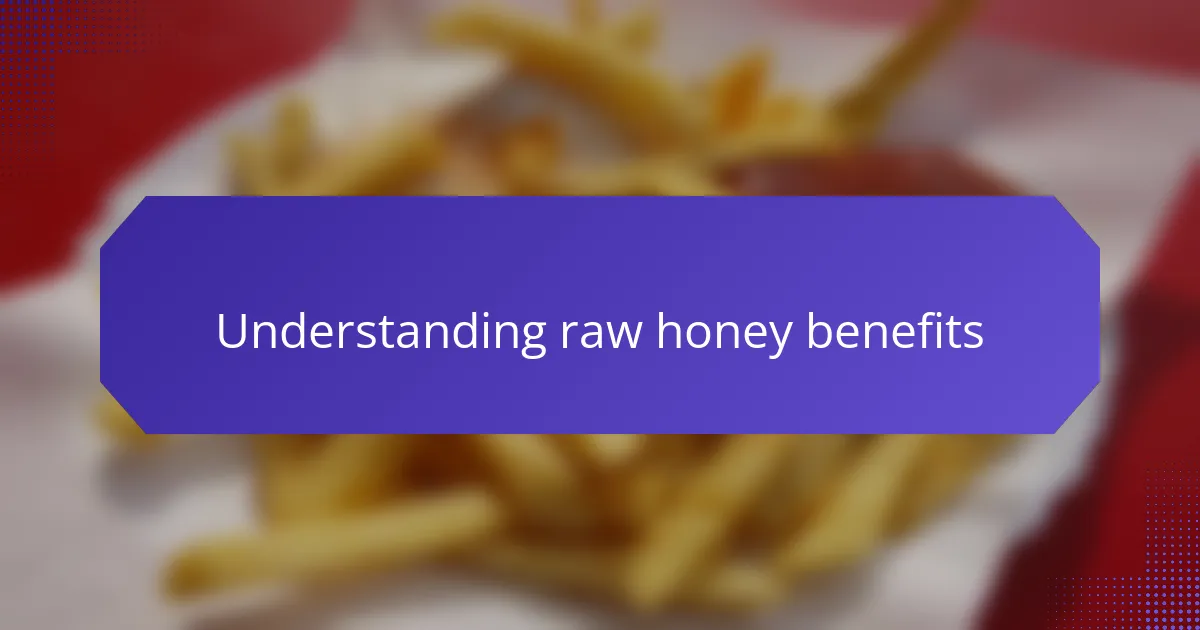
Understanding raw honey benefits
When I first started using raw honey in my baking, I was amazed at how much flavor it brought to my treats. Unlike processed honey, raw honey retains its natural enzymes, vitamins, and minerals, making it not just a sweetener but a nutrient-rich ingredient. I remember tasting my first batch of cookies sweetened with local raw honey, and it was like rediscovering a childhood favorite—each bite was bursting with depth and warmth.
Understanding raw honey’s benefits goes beyond just its taste. It’s unfiltered and unprocessed, which means you get all the good stuff straight from the hive. This natural sweetness not only enhances flavors but also offers a range of health perks. Here are some of the most notable benefits I’ve discovered:
- Contains antioxidants that help combat oxidative stress
- May have antibacterial properties, promoting wellness
- Acts as a natural energy booster, perfect for a baking day
- Provides soothing relief for sore throats
- Supports local agriculture and beekeepers, boosting the community
Using raw honey has truly transformed my approach to baking, making the process not only healthier but also more meaningful.
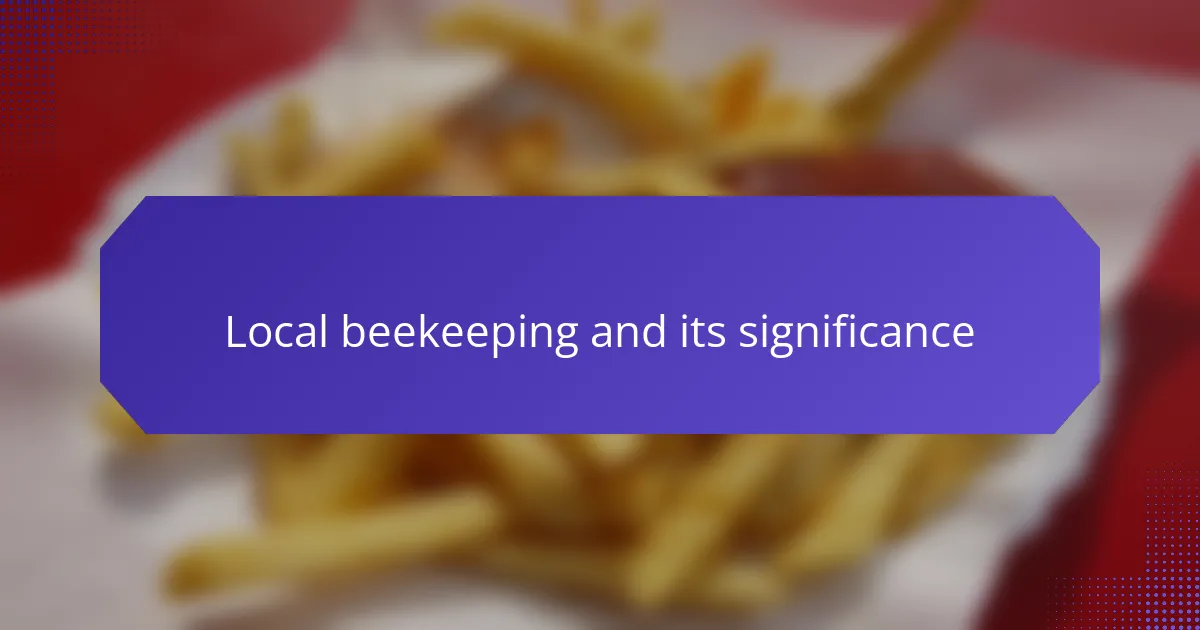
Local beekeeping and its significance
When I think about local beekeeping, I realize how much it connects us to our environment and community. It’s fascinating to know that every jar of raw honey is a product of hard work from local beekeepers, who dedicate their lives to nurturing bees and their habitats. Have you ever wondered about the symbiotic relationship between these bees and our food system? Without them, much of our agricultural landscape would suffer.
Supporting local beekeepers means supporting biodiversity. I recall visiting a nearby apiary and standing in awe as the beekeeper explained how each bee plays a crucial role in pollination. It’s remarkable to think that by choosing local honey, we’re not just enjoying a delicious sweetener; we’re actively contributing to the survival of bee populations and, by extension, the health of our ecosystems.
Beekeeping fosters a sense of community, too. When I purchase honey from local producers, I feel connected to these artisans and their commitment to sustainable practices. It reminds me that we all share a responsibility for safeguarding our planet, one sweet drop at a time. What better way to create meaningful connections than over a shared appreciation for the bounty our local bees provide?
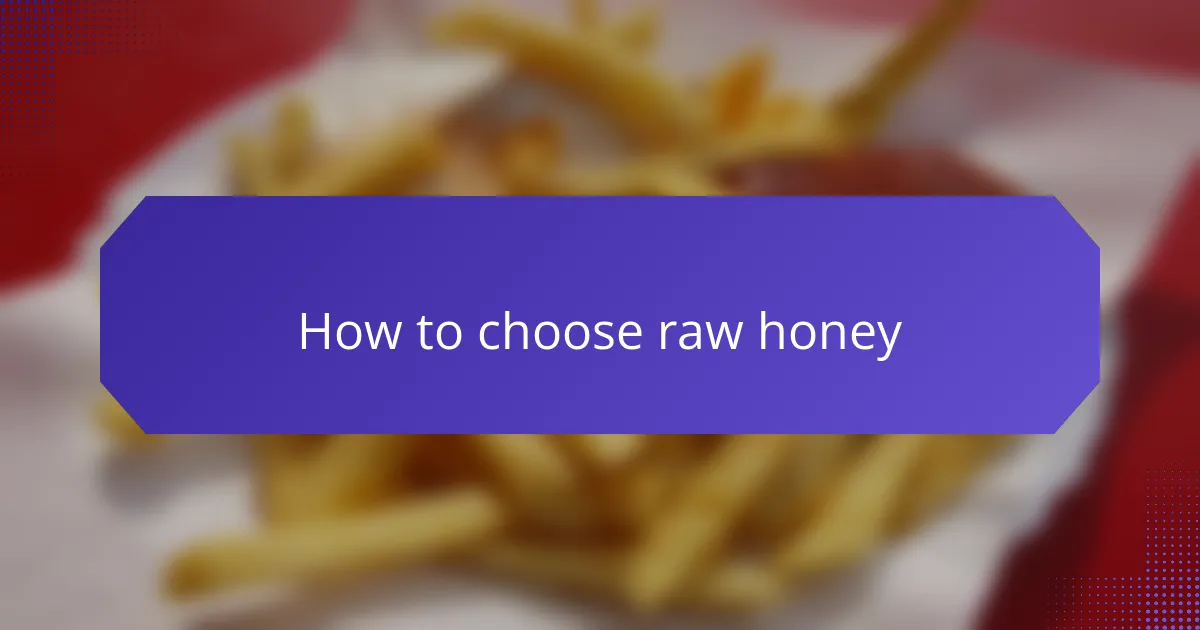
How to choose raw honey
When selecting raw honey, I always look for products labeled as “raw” and “unfiltered.” This ensures that what I’m getting is as close to nature as possible, preserving its nutrients and unique flavor profiles. I remember the first time I tasted honey straight from a local beekeeper—it was like a sweet revelation. The complexity of flavors far surpassed anything I had purchased from the store.
Here are some tips for choosing the best raw honey:
- Source: Look for honey from local beekeepers to support your community and ensure freshness.
- Color and Consistency: Raw honey can vary in color and may appear cloudy; this is a good sign of purity.
- Taste Test: If possible, sample different varieties to find your favorite flavor. I love experimenting with floral notes!
- Packaging: Choose honey in glass jars rather than plastic, as it’s better for preservation and environment.
- Certification: Check for certifications or labels that guarantee it is truly raw and unadulterated.
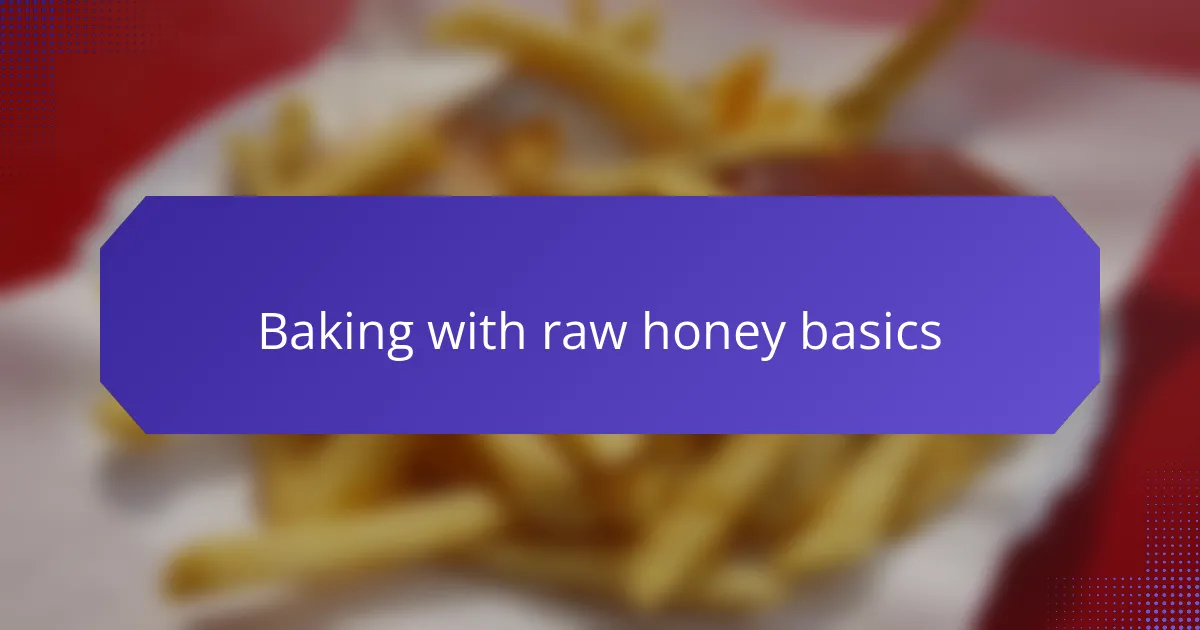
Baking with raw honey basics
When I first started baking with raw honey, I was surprised by the difference it made. Unlike processed sugar, raw honey carries a rich, nuanced flavor that adds depth to desserts. I remember the first time I substituted honey in my favorite cookie recipe; the warmth of its sweetness elevated the entire batch.
One aspect to keep in mind is that raw honey is sweeter than regular sugar, so you’ll typically need less of it. I always recommend experimenting a bit to find that perfect balance for your taste buds. Also, the moisture content in honey can affect the overall texture, which can lead to delightfully chewy baked goods. Trust me; it’s worth the little extra effort!
| Aspect | Raw Honey | Sugar |
|---|---|---|
| Flavor | Rich and complex | Pure sweetness |
| Sweetness Level | Sweeter, use less | Standard sweetness |
| Moisture Content | Higher, adds moisture | Lower, drier |
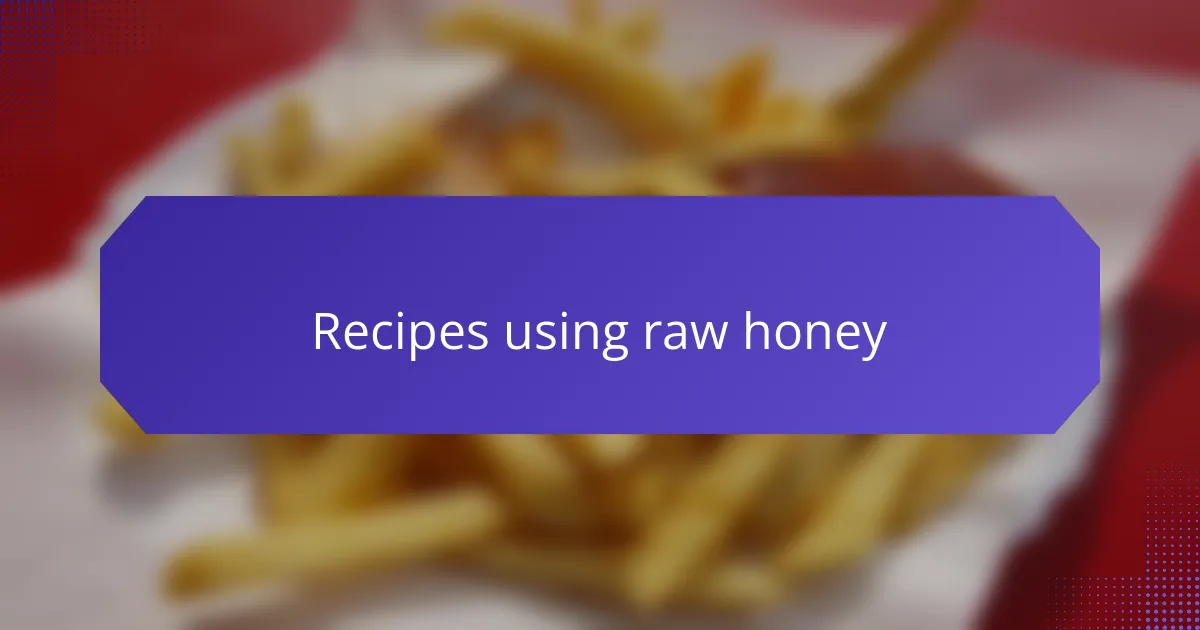
Recipes using raw honey
When it comes to baking with raw honey, there are so many delightful recipes to explore. One of my favorites is honey-sweetened banana bread. The banana’s natural sweetness pairs perfectly with the rich flavor of the honey, creating a moist and tender loaf. I love the aroma that fills my kitchen while it’s baking—it’s nothing short of comforting. Have you ever experienced that warm, inviting smell? There’s just something special about it.
Another delightful treat is honey oatmeal cookies. They’re chewy, slightly crunchy, and, most importantly, bursting with flavor. I remember the first batch I made; the honey added a complexity that simply sugar could never match. I often mix in nuts or dried fruits for that added texture and flavor—it’s such an easy tweak that transforms the entire cookie experience.
For a more adventurous spin, I recently tried making a honey glaze for roasted vegetables, and wow, was I impressed! The caramelized sweetness of the honey enhanced the natural flavors of the veggies, making them downright irresistible. I learned that raw honey can even shine in savory dishes, proving its versatility in the kitchen. It’s incredible how one ingredient can elevate so many different recipes. Have you tried incorporating honey into your savory meals? Trust me, it’s a game changer!
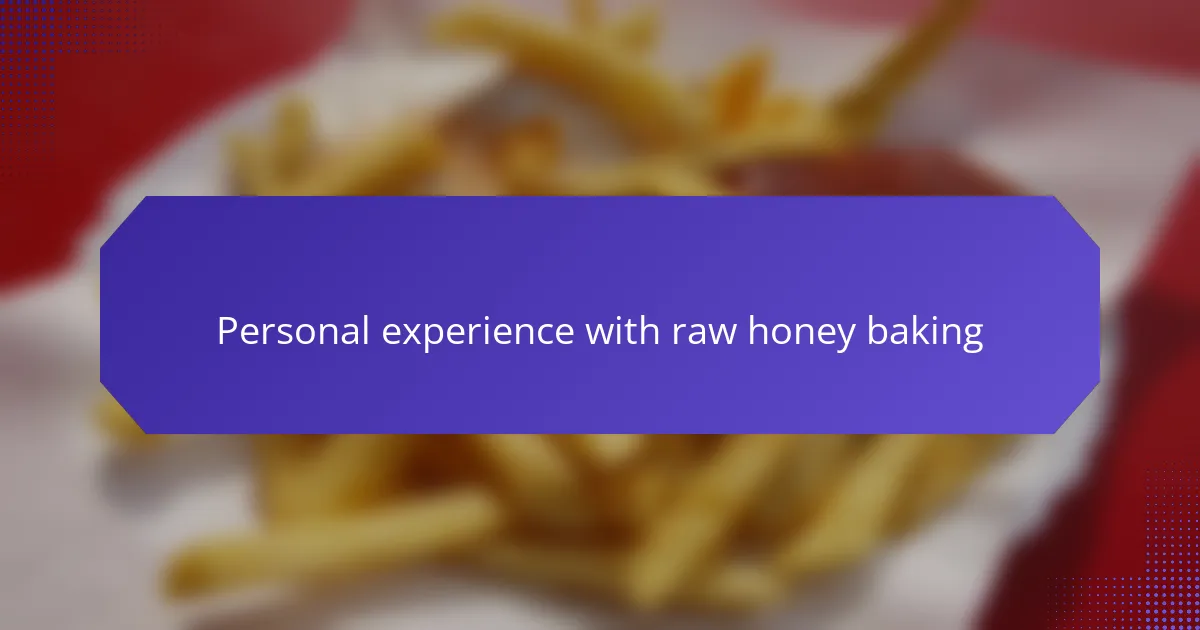
Personal experience with raw honey baking
When I first decided to bake with raw honey sourced from local beekeepers, I was pleasantly surprised by its rich flavor and unique qualities. The aroma that filled my kitchen was nothing short of captivating, and it reminded me of warm summer afternoons spent observing bees buzzing around gardens. I felt a genuine connection to the local community, knowing that my baking was supporting small-scale farmers and their hard work.
One standout experience was when I replaced sugar in my favorite banana bread recipe with raw honey. The result was a moist, naturally sweet loaf that resonated with a depth of flavor I hadn’t encountered before. I couldn’t help but share slices with friends, who marveled at the difference. It’s moments like these that reinforce how impactful choosing local ingredients can be in our cooking adventures.
| Traditional Sugar | Raw Honey |
|---|---|
| Standard sweetness | Richer, more complex sweetness |
| Adds no nutritional value | Contains vitamins and antioxidants |
| Less moisture content | Increases moisture in baked goods |
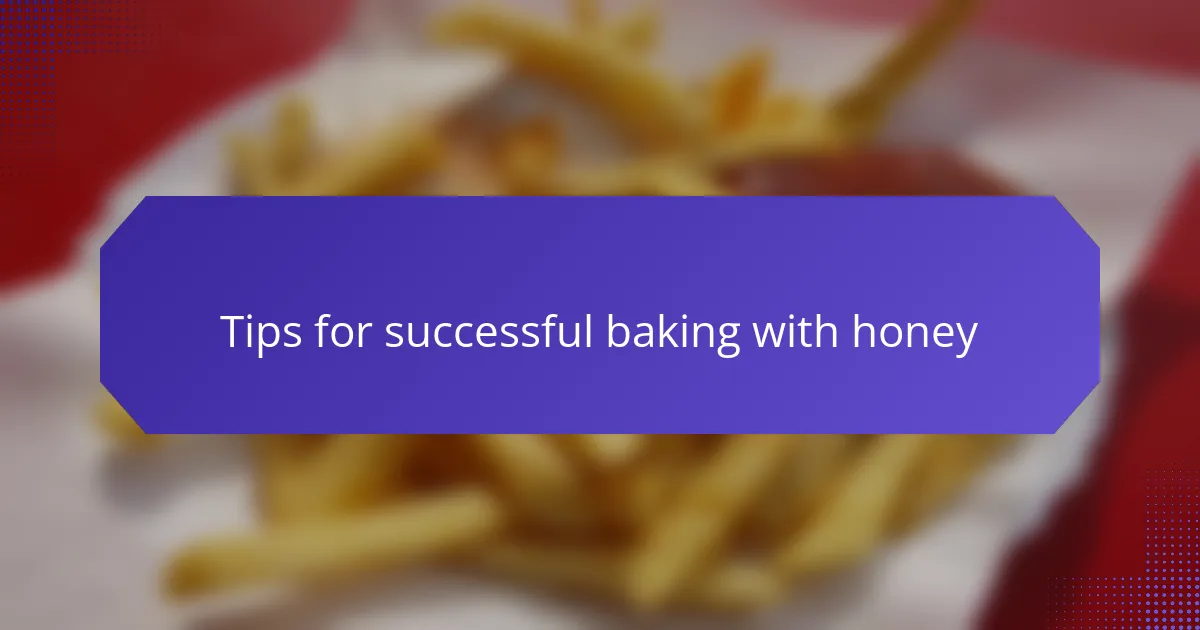
Tips for successful baking with honey
When baking with raw honey, it’s crucial to adjust your recipe since honey is sweeter than granulated sugar. I usually start by reducing the amount of honey by about one-third and am amazed at how I still achieve that perfect balancing act of sweetness. Have you ever tried a recipe only to feel it was just too sweet? Adjusting honey can bring out the other flavors beautifully.
Temperature matters too. If you’re using honey in recipes that require heating, keep in mind that high temperatures can destroy some of its beneficial properties. I learned this the hard way when I baked my first batch of honey-glazed muffins. I was so excited but ended up sacrificing some of that rich, complex flavor. Bake at lower temperatures for the best results and to retain its unique goodness.
Finally, I can’t stress enough how important it is to mix honey into your wet ingredients before adding dry ones. This creates an even distribution throughout your batter. The first time I did this, the result was a consistently flavored treat that made such a difference! That’s when I discovered the secret to baking perfection—little adjustments can lead to marvelous outcomes. Wouldn’t you love to enhance your recipes with these simple tips?


